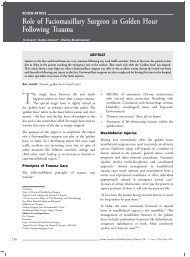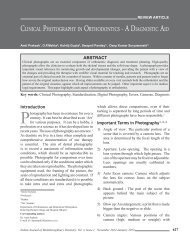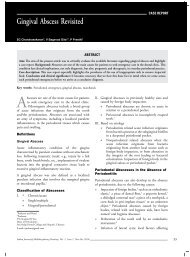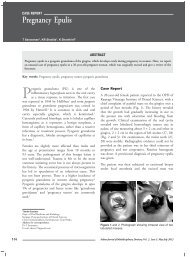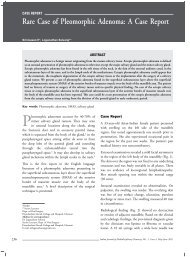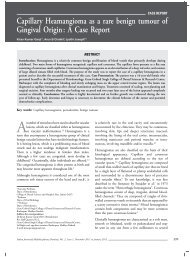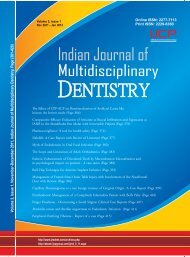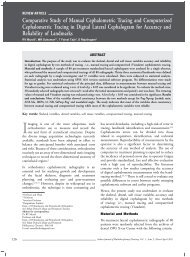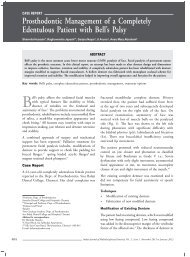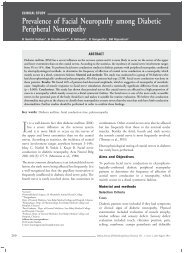Volume 2 - Issue 4 (Aug-Oct) Download Pdf - IJMD
Volume 2 - Issue 4 (Aug-Oct) Download Pdf - IJMD
Volume 2 - Issue 4 (Aug-Oct) Download Pdf - IJMD
- No tags were found...
Create successful ePaper yourself
Turn your PDF publications into a flip-book with our unique Google optimized e-Paper software.
Original Researchmentioned. The variation between those two planeswas found to be an average of 9.66 degrees with astandard deviation of 4.29 degrees.In this study all the three commonly mentionedreference points of tragus were taken intoconsideration [superior, middle and inferior point onthe border of the tragus of the ear], for comparison ofangles with occlusal plane in south Indian population.It was shown in this study that the mean differencebetween the inferior ala tragal plane angle and theocclusal plane angle was less and was almost equalto the mean difference between the occlusal planeangle and lower lip line on smile angle with the‘P’ value of 0.07 which was not significant (Table3), means both were relatively parallel to occlusalTable – 3: comparison between OP-LPL and OP-ATIGroups N Mean SD t-value P-valueAngle between OP-LPL in degrees 50 11.50 6.59 0.07Angle between OP 1.808 (Not-ATI in degrees 50 12.94 5.78 Significant)plane but angle between OP-ATI were recordedwith a maximum of 29.43 degrees and minimumof 3.42 degrees whereas, angle between OP-LPwere recorded with maximum of 26.4 degrees andminimum of 1.57 degrees. The conflicting ideasabout ala-tragus plane make it further a unreliablelandmark to be used for the construction of completedentures. However from the present study, we couldinfer that the ala to the lower tragus border line is alsonear parallel to the occlusal plane. The correlationcoefficients of the lower lip line to the occlusalplane were greater than that of the upper, middle orlower ala tragal plane to the occlusal plane. Also,when we predict the occlusal plane from the lowerlip line, the standard error of estimate is less. Thatmeant that the prediction of the occlusal plane fromthe lower lip line on smile is more reliable than fromthe ala-tragus plane.One study revealed that camper’s plane was notparallel but inclination was similar to naturalocclusal plane. In a similar study, Vojvodic et al 12recommended camper’s plane but the orientationwas questionable posteriorly. Masakata et al 13recommended that tongue margin should lie on lingualedge of the lower occlusal plane. Ismail 14 suggestedthat occlusal plane should lie on 2/3rd of retromolarpad but it was lower than natural plane. Ping Hsienet al 15 used the mandibular plane in determining theocclusal plane for complete denture patients since itwas a stable landmark and more reliable with classI malocclusion cases but the variation in the anglefor the other malocclusion makes it not possible.Weishy 16 studied on Frankfort’s horizontal plane butits variability makes it difficult to assess occlusalplane.An open rest concept 22 was mentioned in the literatureby James Douglas, in which, “open rest” position isan unstrained mouth-breathing position with minimallip separation. It is a position in which the dentistcan observe or obtain a mental picture of the mesialmarginal ridge of the upper and lower first bicuspidteeth in relation to the commissure of the lips and onstudy with this position showed the upper and lowerocclusal planes in relation to the commissure of thelips with the mandible in an “open rest” position in 50complete denture patients closely paralleled the studyof patients with natural teeth.In the present study, the farthest distance from theocclusal plane to the lower lip line on smile was0.7 mm showing that this landmark is closer tothe occlusal plane and is more reliable and easilymarked in the occlusal rims during the procedure.In addition, it is more convenient in a clinicalpractice to obtain a natural head position and lowerlip line by asking the patient to smile, in this studyout of 50 samples, 21 samples showed that the lowerlip line was parallel to only anterior plane and restof the 29 samples recorded that lower lip line wasparallel to both anterior and posterior occlusal plane.With these findings we reveal the probability thatlower lip line in most of the cases is parallel to bothanterior and posterior occlusal planes. However,further studies are encouraged to accept the validityof the statement mentioned above.ResultsOn gross evaluation, the angle between OP-LPL,has got minimum of 1.57 degrees and maximum of26.4 degrees (Table 1,2). Out of 50 samples, and in21 subjects the lower lip line was parallel to onlyanterior plane and rest of the 29 subjects recordedthat lower lip line was parallel to both anterior andposterior occlusal plane. Likewise for the anglebetween OP-ATS has got 3.99 degrees and maximumof 34.13 degrees, for the angle between OP-ATMhas got minimum of 4.82 degrees and maximum of548Indian Journal of Multidisciplinary Dentistry, Vol. 2, <strong>Issue</strong> 4, <strong>Aug</strong>ust-<strong>Oct</strong>ober 2012



